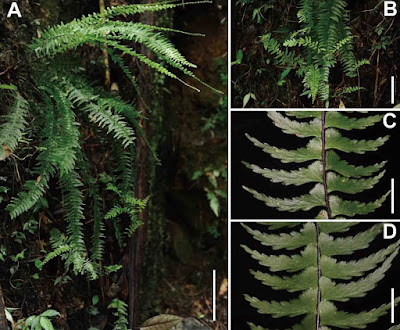 |
| Asplenium normale f. scythiforme Z.X. Chang
in Chang, Kuo, Lu & Huang, 2020
(Photos by Pi-Fong Lu & Zhi-Xiang Chang)
|
Abstract
Evolutionary histories of species complexes in ferns are usually complicated with hybridization and polyploidization. In the Asplenium normale D.Don complex, we here identify a new taxon - Asplenium normale f. scythiforme Z.X. Chang, f. nov., by clarifying its position in the reticulated tree of the species complex. Our phylogenetic and flow cytometric results surprisingly support that this new taxon is a non-hybridized diploid and conspecific with A. normale. Nonetheless, the forma scythiforme can be separated from the normale by having more dissected and falcate pinnae with apices acuminate to fishbone-like tails. Currently, A. normale f. scythiforme was found to be endemic to Taiwan with only one northern and one southern populations.
Keyword: Asplenium normale f. scythiforme, Asplenium normale complex, flow cytometry, morphology, phylogenetic
Asplenium normale f. scythiforme Z.X. Chang, f. nov.
鐮羽鐵角蕨
Distribution: This forma is currently known with only two small populations that grow in Chamaecyparis montane mixed cloud forest and Pasania–Elaeocarpus montane evergreen broad-leaved cloud forest (Li et al., 2013) in northern and southern Taiwan respectively, and coexists with Asplenium normale f. normale. We speculate that the local populations have propagated asexually with vegetative buds.
Etymology: The ‘‘scythiforme’’ means the pinnae shape like the scythe, which was used to mow the grass.
Note: Since 2007, we have never seen any individuals that producing fertile leaves in wild as well as three-year planted individuals in the Dr. Cecilia Koo Botanic Conservation Center (KBCC).
Zhi-Xiang Chang, Li-Yaung Kuo, Pi-Fong Lu and Yao-Moan Huang. 2020. New Addition to the Asplenium normale complex (Aspleniaceae): An Endemic forma in Taiwan. Taiwania. 65(2); .253-260.
